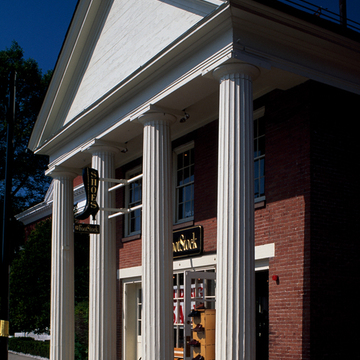Milling began in 1639–1640 on Mill Brook in Concord; the area around the dam became the commercial center of the community in the eighteenth century. In 1828, the Milldam Company was incorporated to purchase the properties on and near the milldam, drain the pond, and redevelop the commercial core. Along a gravel road on the site of the milldam, the company built new structures and sold lots for new commercial development. The first block of Main Street retains the area's most intact commercial district from the second quarter of the nineteenth century. The dominant early building in this block is the Concord Bank (1832) at 46–48 Main Street. Built just west of the site of the colonial gristmill, the bank was the first Greek temple-form building in Concord and the first bank in the community. Immediately east of the bank are two buildings that were constructed before 1830, making them the earliest surviving structures from this new development. The two-story brick store at 42–44 Main Street has first-floor bay windows, a restoration designed by Harry B. Little in the 1940s. Across Main Street, numbers 29 and 23–25 (1830s) and numbers 37–41 (c. 1845) are two-story Federal-style commercial buildings with high parapet double chimneys in their end or party walls. The adjacent district is composed of converted residences and later commercial buildings that have maintained the basic scale and character of these earliest structures.
You are here
Milldam District
If SAH Archipedia has been useful to you, please consider supporting it.
SAH Archipedia tells the story of the United States through its buildings, landscapes, and cities. This freely available resource empowers the public with authoritative knowledge that deepens their understanding and appreciation of the built environment. But the Society of Architectural Historians, which created SAH Archipedia with University of Virginia Press, needs your support to maintain the high-caliber research, writing, photography, cartography, editing, design, and programming that make SAH Archipedia a trusted online resource available to all who value the history of place, heritage tourism, and learning.











